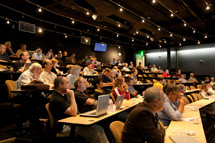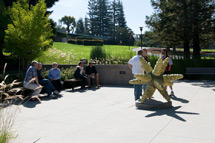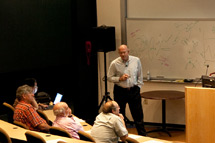
Handy Links
SLAC News Center
SLAC Today
- Subscribe
- Archives: Feb 2006-May 20, 2011
- Archives: May 23, 2011 and later
- Submit Feedback or Story Ideas
- About SLAC Today
SLAC News
Lab News
- Interactions
- Lightsources.org
- ILC NewsLine
- Int'l Science Grid This Week
- Fermilab Today
- Berkeley Lab News
- @brookhaven TODAY
- DOE Pulse
- CERN Courier
- DESY inForm
- US / LHC
SLAC Links
- Emergency
- Safety
- Policy Repository
- Site Entry Form

- Site Maps
- M & O Review
- Computing Status & Calendar
- SLAC Colloquium
- SLACspeak
- SLACspace
- SLAC Logo
- Café Menu
- Flea Market
- Web E-mail
- Marguerite Shuttle
- Discount Commuter Passes
-
Award Reporting Form
- SPIRES
- SciDoc
- Activity Groups
- Library
Stanford
Around the Bay
Accelerators and Astrophysics Featured at the 2009 SLUO Annual Meeting
The 2009 SLAC Users Organization annual meeting on Thursday, September 17, brought nearly 100 users from around the world to SLAC's Kavli auditorium for discussion of funding, cosmology and SLAC's role in past, present and future accelerator science and accelerator-based physics.
"This is a vibrant community of physicists and astrophysicists," said SLUO chairperson Gérard Bonneaud. "The accelerator and non-accelerator communities are merging very well, which is a unique feature of SLAC's Particle Physics and Astrophysics Directorate."
Representatives from the National Science Foundation and the Department of Energy spoke during the morning session of the meeting. Michael Procario, director of the facilities division in the DOE Office of High Energy Physics, discussed the importance of building tools to deliver science to many laboratories and universities in the United States.
"The U.S. high-energy physics program is at a crossroads, and we need to start making investments in new tools for the field," he said. Procario stressed the importance of U.S. involvement in particle physics projects such as the Daya Bay Reactor Neutrino experiments, Dark Energy Survey and NuMI (NOvA) Off-axis Electron Neutrino Appearance Experiment, which are already being built. Others, such as the Long Baseline Neutrino Experiment and the Joint Dark Energy Mission, are just being planned. The new Office of Science Early Career Research Program has been established to fund the most promising new researchers in universities and DOE national laboratories, Procario noted.
The meeting agenda then turned to the cosmos and non-accelerator physics, with a close look at the successful first year of the Fermi Gamma-Ray Space Telescope and panel discussions of emerging astrophysics projects, including the Joint Dark Energy Mission, Cosmic Microwave Background project, Cryogenic Dark Matter Search, and the Advanced Gamma-ray Imaging System. Discussion of new groups raised questions about how all these developing projects can be supported in the future.
"The presentations about all four projects were very exciting, but we cannot do everything," Bonneaud said. SLAC's Particle Physics and Astrophysics Directorate resources and personnel may be spread too thin to support all these new groups. "Also, we cannot do it by ourselves; we must establish links to local, national and international communities and make collaborations."
The afternoon session put accelerator science and accelerator-based physics in the spotlight. SLAC Director emeritus Jonathan Dorfan addressed the number of achievements SLAC has made in its storied history—both in accelerator technology and resulting scientific discoveries—and reminded all present of the important role SLAC still plays in accelerator physics.
"As our new name attests, accelerators have been a key technical ingredient at SLAC and remain so," Dorfan said. He talked about SLAC's numerous scientific and technological achievements, explaining that innovation rests upon human and physical infrastructure, long-term commitments to science, wise leadership, few boundaries, and being flexible, tenacious and patient. "These elements have all played a crucial role to SLAC success," Dorfan concluded. "My hope is that the powers that be have the foresight and the boldness to preserve these elements here so that SLAC science, be it accelerator or non-accelerator, will continue to turn the scientific world upside down with its brilliance."
The remaining sessions launched into discussion of the present and future responsibilities of SLAC in accelerator physics, both in the U.S. and abroad. Presentations included information on new silicon accelerator chips being studied at Stanford University, advanced accelerator research at FACET, and the next steps in accelerator science in view of three forefront physics cases: the next-generation B-factories, the upgrade of the Large Hadron Collider and a future lepton collider. Each presentation pointed to SLAC's ability to play a large role in future accelerator physics firsts.
"Accelerator science is very alive in this lab," Bonneaud said. "People have a lot of projects and ideas. We will help to set up collaborations and bring international collaborators. We are part of the world-wide accelerator physics community."
—Lauren Knoche
SLAC Today, September 22, 2009


